Upcycle 2020. Balance
Benjamin Chang
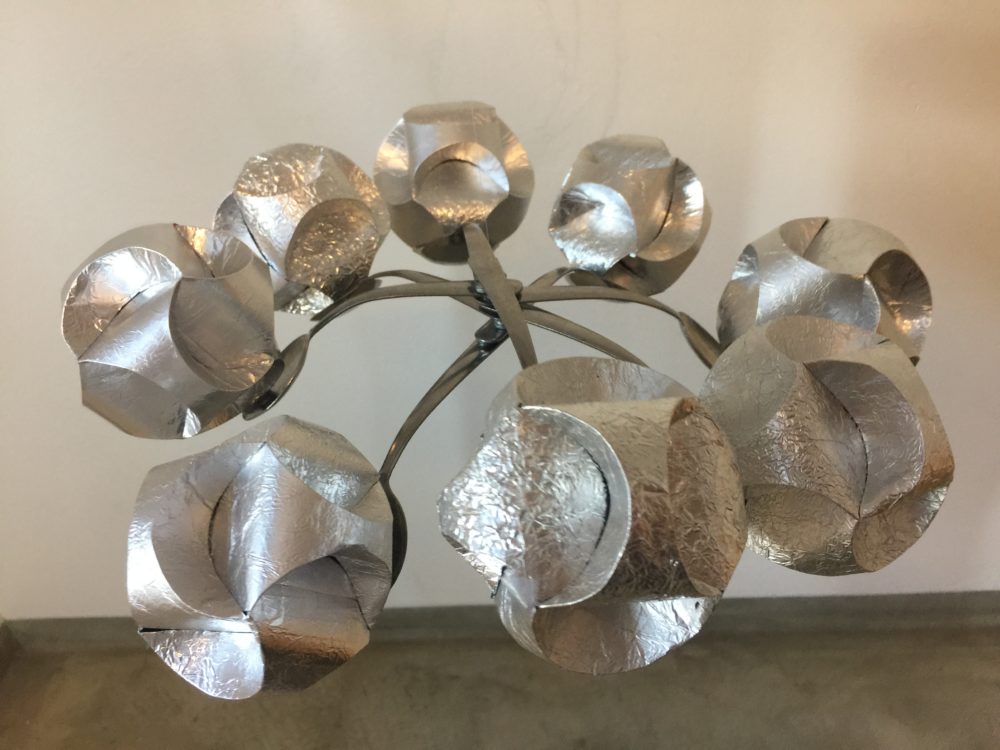
Introduction
When starting this upcycling project I knew from the beginning I didn’t want to purchase any material of any sort. However, it wasn’t out of the question of gathering through asking around looking for resources to supply a project. When looking for inspiration I came across an installation artist Olafur Eliasson. His works cater towards an aesthetic of fragile shapes and large interactive pieces of art. One art aesthetic I was drawn to his renditions of paper globes. I am drawn to the the objects he creates because of their structure, they are quite unique and from a designers perspective quite marvelous. Here is where I decided to move the project to focus on the aesthetic of paper globes.I also wanted to find a way to present the intricacy of these globes, to show a side of delicacy. With the combination of tinfoil, paper, spoons, and magnets, I’ve created a piece that shows off the brilliance of an object, yet presented in a way that edges a fine line of balance. My aim was to create something that would be simple yet challenging. This was the basis behind my upcycle creation.
 Olafur Eliasson Globes
Olafur Eliasson Globes
Vision
My vision when working through this process changed, I allowed myself to follow new paths if I see them fit. I began this project with a sole emphasis on spoons, contorting their shapes and exploring a new view on everyday objects. When my introduction of tin-foil transitioned in, I felt as if I had two things to pair, rather than trying to mold one thing into something. One principle I referenced from my aesthetic inspiration of ‘Conjunction’, focused on using two separately related things and combining them to create a ‘new thing’ that is codependent on each other.
It was easier to concept and work through ideas for the project once I knew I had multiple materials involved, it allowed a further venture of exploration. Ultimately I envisioned something that represented that aesthetic and hence a creation of balance was necessary.
My Design Process
To first mention, I am not a mechanical designer in any sort, I work mainly with graphic elements. However, I did not find the design knowledge I know and practice to be useless, I focused on my ways of concepting through sketching. Having the ability to quickly draw free flowing ideas allowed me to remember and focus on details I may miss when just brainstorming. Having the ability to move from one idea to the next helped me figure out what I do like and what I don’t like. This moved me forward into the phase of creation, a place I am not as familiar with when it comes to physical creation.
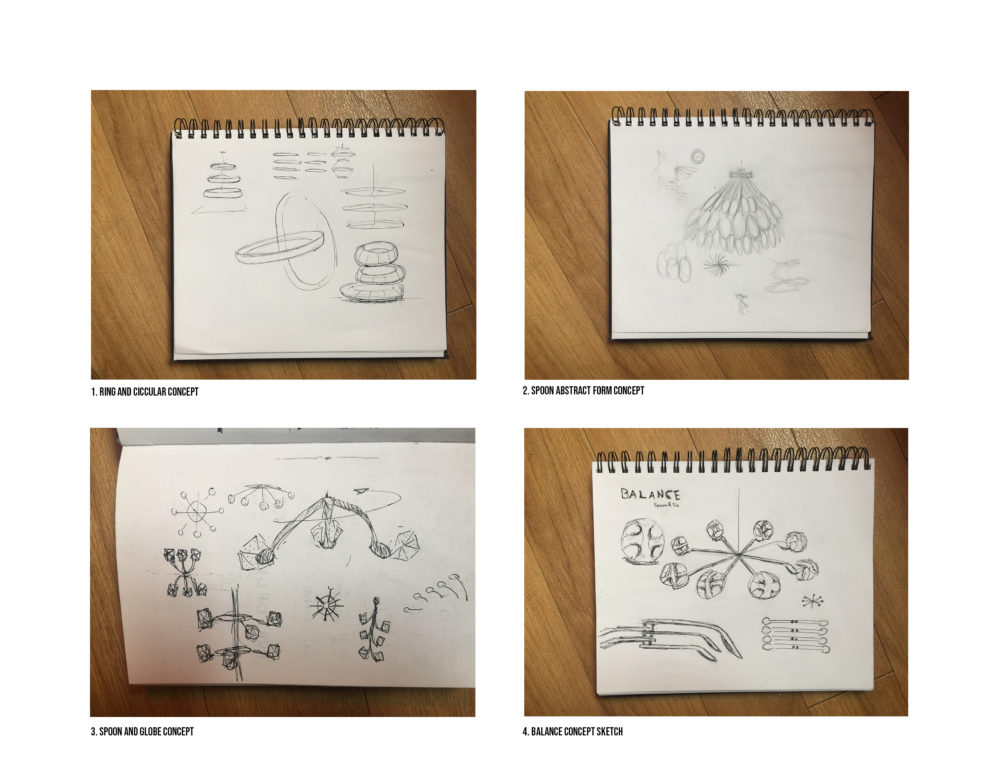
I also allow myself to stew on ideas, allow them to grow freely in the back of my mind, only to hope for a serendipitous moment to arise. Luckily, this occurred during this project, this came in trying to find a pairing material for my spoons. While eating lunch, I noticed the tin foil that was wrapping my sandwich. It dawned on me that this sheet of metal foil, is consumed and thrown away without a second thought, it gets covered in food then becomes forgotten. I looked at this material and appreciated its malleable nature and reflective appearance, a perfect material to pair. From here, I moved forward in designing the use of tin foil. Unsure of how I wanted to use this material I went back to designing. I noted the features of the material, it was shiny, textured uniquely, holds shape, and comes in large squares.
From here I drew inspiration from my brother, an origami enthusiast. He creates much of his work with foiled paper, he finds the material structurally supportive and easy to work with. With this in mind, I decided to integrate an origami aesthetic when creating working material for the tin foil. Drawing back to Eliasson’s globes, I knew that combining origami and his globe aesthetic would be a perfect final focus.
From here I searched for interesting ways to create spheres using paper. I found a paper artist and toy maker under that name of Hattifant. Here they provide templates for paper spheres known as Triskele Paper Globes. These globes followed a simple three paper strand method, in which the strands all get interlocked and folded down in a repeated pattern. I found this template to be perfect for creating tin-foil globes. The only trick was how to create the tin foil outside.
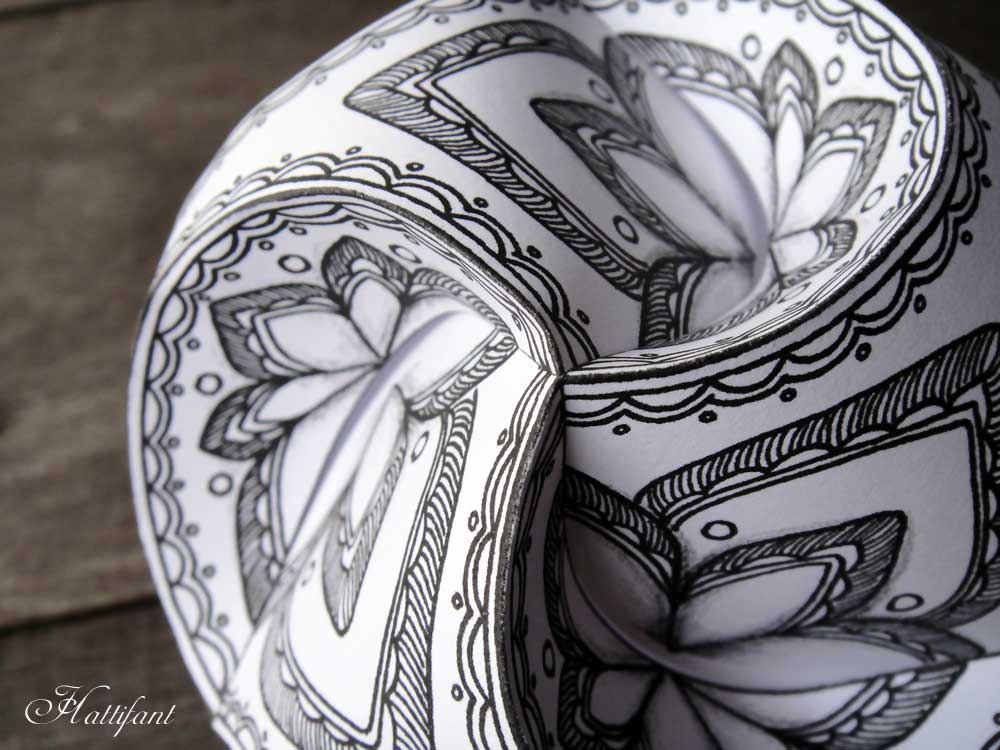 Hattifant Triskele Globes
Hattifant Triskele Globes
Fabrication Process
Spoons
Collecting the spoons was an easy thing to manage. As an RA I have residents who often steal silverware from the C4C, in this I found them a unique and interesting item to upcycle. A bent spoon was a simple inspiration that I decided to flow with.
This process was quite simple, I took a number of spoons and began bending them in unique ways to play with the view of the object. Ultimately I decided to bend the spoons in an exaggerated fashion, one that shows an action of dumping, one that would play well with the introduction of the globes.
Plain and simple I bent 8 spoons to match, each acting as a functioning piece.
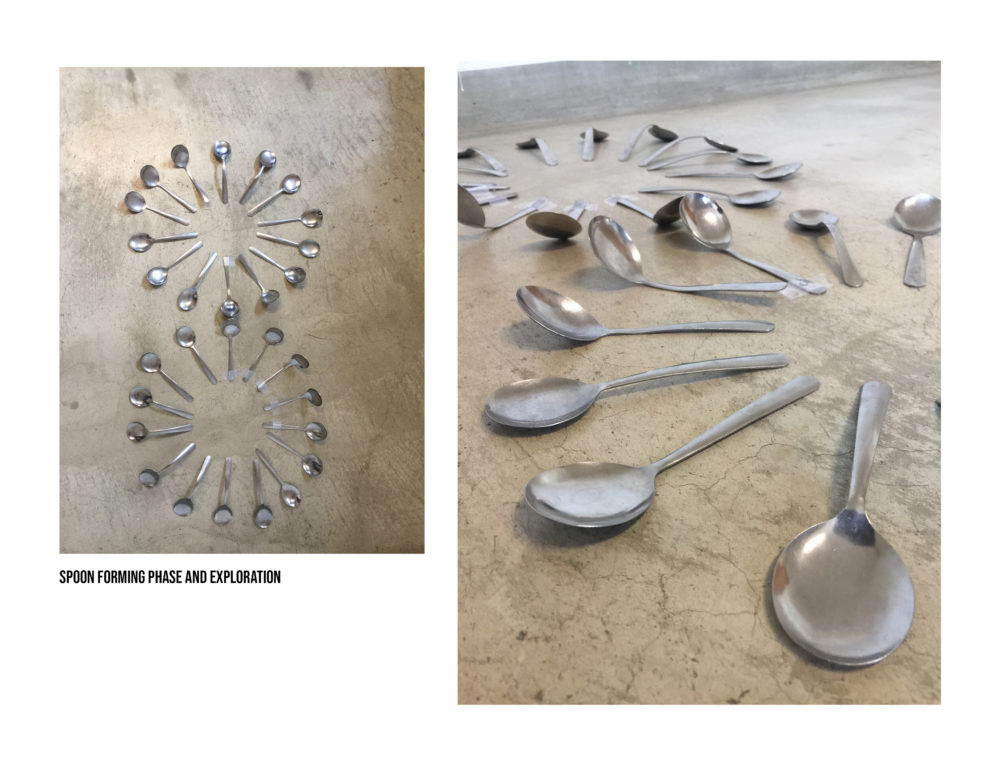
Globes
The first part in collecting my material was collecting thrown out sandwiches. It was here I reclaimed, cleaned, and pressed dozens of sheets of foil.
Following the foil, I created 24 paper templates, and 24 trimmed construct paper frames. These were all made to be combined into foiled sheets. From here I trimmed down each foiled sheet to fit the needs of every paper frame.
Following this, I used the template to score the needed outline shape onto the construction paper. Once scored, I used double sided tape to attach the sheets of foil. From here I would reverse the sheeting and fold in any excess foil. From here I would take each tin ribbon and tape them into rings. After three rings were created, I could then interlock them and tape them together. Finally, I would fold down the scored indentations with the foil, and after folding in each section a globe is created. In total, each globe was constructed of 6 layers of combined material, each creating a uniquely texture object. After all eight were created, I was pleased with the overall delicacy yet rigidness of each globe. I was delighted by the sudden joy of a once forgotten waste.
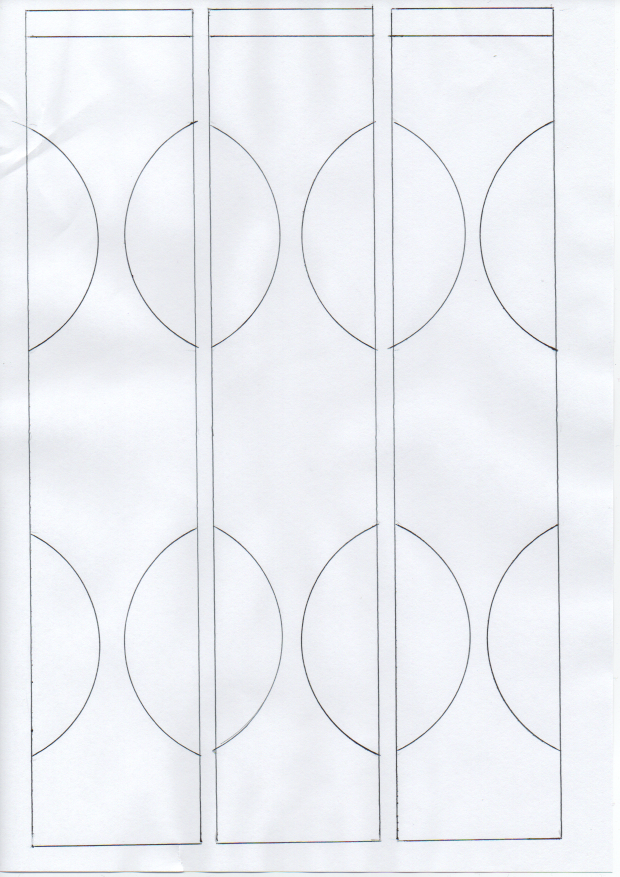

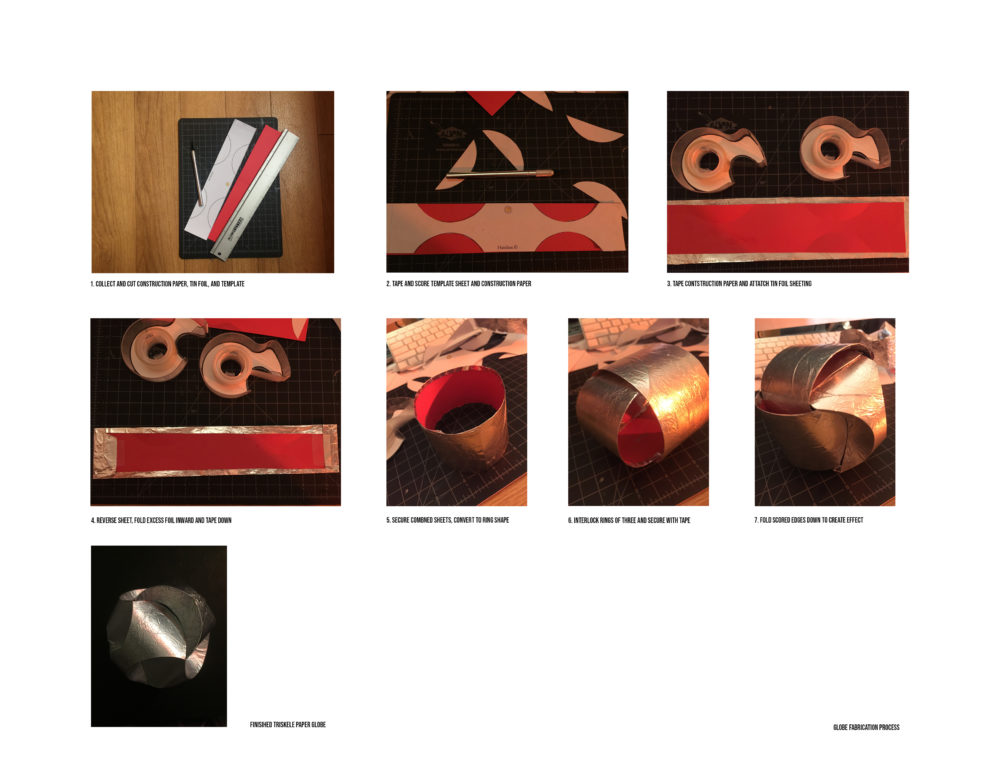
Combining
The design was simple when combining these two formed objects. I knew from the beginning of my concepting process that I wanted interaction and play of motion to be incorporated. Knowing the idea of balance, I decided to use magnets to combine the spoons in a unique symmetrical fashion. From here I combined segmented pieces and joined them through the use of interlinking magnets. The magnets played a key role in helping play with interaction, they allowed the combined objects to free-float yet stay connected, I enjoy the piece being held together through magnetic force, it’s a unique nature when used in this fashion. With these magnets I attached each globe to the end of the spoon, showing them seemingly falling off.
Conclusion
Finally, to end it, I needed a simple way of displaying the combined piece. Fishing line, it is a material I use frequently, it is a material I recognize as invisible yet strong. It was the perfect way to tie this piece together. Through a simple knot through the top section, this object could now free flow and move freely, as it should be presented.
Youtube Link: https://youtu.be/uuAYRIRITl0
References
Olafur Eliasson Globes olafureliasson.net/archive/exhibition/EXH102539/olafur-eliasson-in-real-life#slideshow.
Olafur Eliasson “Conjunction” : Shuab, Mirjam. The Logic of Light Technology and the Human Connection. Walther Konig Verlag, 2009.
Triskele Paper Globes Manja, et al. “Triskele Paper Globes.” Hattifant, Hattifant, 24 May 2019, hattifant.com/triskele-paper-globes/.

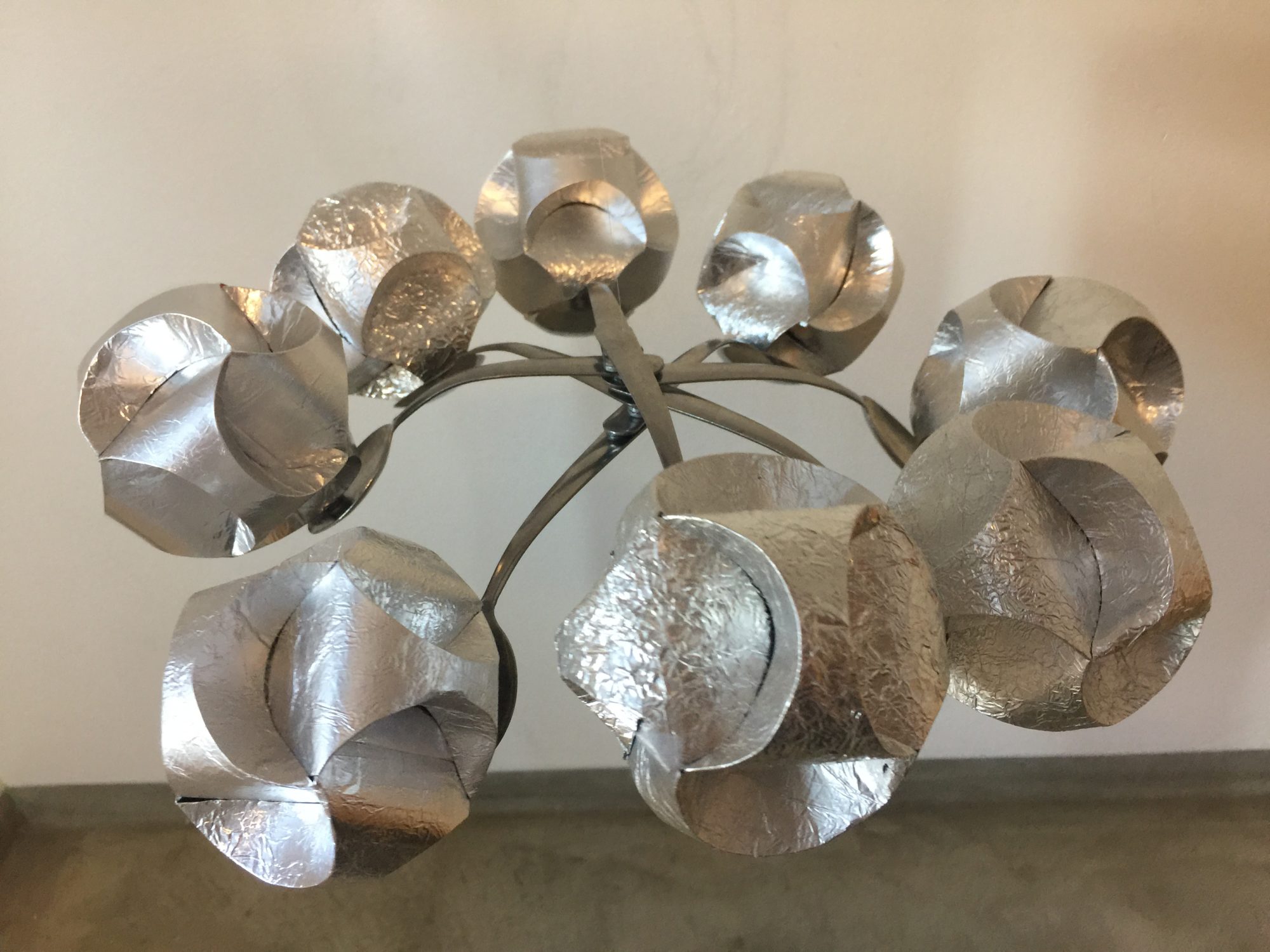
8 Comments. Leave new
Presentation Critique:
Statement of Meaning: I love how well you explained your inspiration and specially your design process during your presentation. I also love your thinking, that you took a material, such a tin foil that just gets thrown away after one use, and you found a new home. Great job!
Ben Robles
I love your color choice an ambition in combining two things that dont normally go together. way to be resourceful by having your residents steal spoons for you.
I am very impressed with the research you did into aesthetic choice. In the end, your project turned out really well and definitely embodies the aesthetic you were trying to achieve.
Ben,
I like the combination of tin foil and spoons, they work really well together. The tin foil pieces look really well done, sturdy for being aluminum foil. It would be cool to see this product scaled up to a massive size. I also like that the string it hangs from can hardly be seen, it gives it a floating look. What made you want to keep all the foil parts silver, did you consider painting some of them? Also the name of your project is perfect!
I liked the inspiration from another artist which lead you to your final piece. I thought the tin foil was a good addition as it harmonized with the spoons.
Cool project, Ben! I thought the idea behind your aesthetic was really interesting. The concept of conjunction and combining two unrelated things can lead to many amazing ideas.
This is a super unique way to use spoons and tin foil! How do you intend to display/use this? Great job achieving your desired aesthetic!
The Triskele globes look super complicated when you look at it, but the way you show the fabrication process it is surprisingly simple!